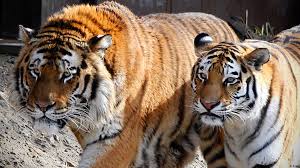Visits: 0

Tiger Breeders, what do they do?
Tigers are magnificent creatures. To view them even up close, much less pet them, seemed like a distant fantasy. Hearing that tiger breeding is becoming commonplace is astonishing. Approximately 7000 tigers are thought to exist in the US alone. They are all inbred tigers. In comparison to the 3900 wild tigers that exist worldwide, there are more inbred tigers in the US. The Tiger Breeders are the focus of this article.

Tiger Breeders, what do they do?
The fact that we no longer need to concentrate on tiger conservation may seem cool to some. Wrong! The inbred tigers pose a threat to tiger conservation. First, the fact that they are domesticated should end the debate. They are inbred tigers, second. The majority of the time, inbred tigers come from various geographical regions and present a significant conservation challenge.
Due to their mixed breeding, these tigers are unable to adjust to environmental changes. The explanation is that a Sumatran tiger’s genetic make-up differs from a tiger from Russia in terms of how well they can adapt to their surroundings. All across the world, different types of people are interested in tiger breeding.
- In the US, some do it to show their wealth, some for emotional support, and some for business purposes. Each breeder has a reason for doing it.
- The breeders who do it for profit have the tiger pose selfies with the visitors for a charge of $45 or more which is not bad at all from the business point of view.
- They are a favorite in state fairs and showcase for play by paying. There is a demand by even shopping malls that drives the demand for it.
- Those baby tigers are kept for cuddling and photo shooting for the visitors. Some have a bucket list to hold a tiger once in their life so these breeders help them achieve this by giving that provision through their tiger breeding business.
- These tigers are trained for circus and roadshows. They travel all over the country entertaining people.
- Breeders help to bring a feeling of wildlife to the masses without having them travel to see those wild animals in their natural habitat.
- Thus helping them to realize their dream of traveling to exotic places without having to go there. It’s a cheap way to fulfill the masses’ dream of being close to wildlife.
Issues with the US’s inbred tigers
Because the law is on their side, tiger breeders in the US are free to carry on as usual. The health of the tigers is more at risk since tiger breeders can breed different tigers from different countries.
Inbred tigers are more susceptible to numerous illnesses than tigers in the wild.
- You can observe eye problems, severe bodily and mental harm, and muscular atrophy.
- It also has an impact on their longevity, according to research.
- These inbred tigers lead limited lives, which are abnormal for wild animals in general and tigers in particular.
- Those large tigers are kept in filthy cages by tiger breeders.
The plight of the tiger cubs.
Since the tiger cubs are valuable, they keep the cubs apart from their mother and bottle-feed them to maintain them in an immature state. Then, unless a sanctuary steps in, they are either sold off, used for breeding, or put to death. This vicious circle keeps going. It is a dishonest practice, but what do you expect from tiger breeders who are only in it for the money? They consider these tigers like a commodity and as such, as such. Inbred tigers are also sold to anyone who want to raise one for profit. The breeders profit from this as well.
Tiger breeders supply tiger cubs all over the country or sometimes even export out of the US. This is not illegal so they continue to do that.
The plight of these inbred tigers is concerning.
- These tigers live off the mercy of the breeders. They eat whatever they feed them.
- Since these tigers were brought out of their natural habitat generations ago, their food habits have changed which causes a variety of health issues for those tigers.
- They are not fed the right diet and proper nutrients required for a tiger. It cost $200 a week in meat to adequately feed a 400-pound pet.
- The tiger breeders are not trained nor do they have the expertise to rear a tiger so these things are bound to happen.
- Any wild animal should not be in our prerogative to take them out of its habitat. But sadly, this is practiced all over the US.
The danger of inbred tigers living in our backyard.
- Research has shown that inbred tigers have a higher chance of attacking humans than their wild counterparts. Why? The reason is those wild ones don’t depend on humans for their food.
- They hunt for it but inbred ones see humans as their source of food. This means that inbred ones if released in the wild have high chances of attacking humans’ settlements for their food.
- Another reason is they have become so close with humans that their friendly blow can rip your hands off. They don’t know the force of their blow which can be detrimental for humans.
- Wild animals belong to the wild but it is an ongoing debate that will need a lot of stringent rules to stop this practice of rearing wild animals into the backyard.
- It is reported that 22 people have been killed since 1990 and countless injured but this practice continues.
- Declawing the big cats involves the amputation of each toe bone, which is the height of cruelty.
- People love to keep them as pets and they will continue to breed them. As long as there is demand, supply will continue.
Texas, a suitable location for tiger breeding?
In states like Texas, it is reported that no one knows how many tigers are kept as pets. The place has a lot of open space, its enormous size which abounds in relatively cheap ranching land makes it ideal for owning one. The statement that says there are more captive tigers in the US than the wild ones in the rest of the world may not be an exaggeration after all as those reports back it up and the disturbing thing is most of these pets may not be registered at all, especially in Taxes.
Why is tiger breeding permitted?
America is a free country, and Americans believe that you have the freedom to do as you like, including keeping a wild animal as a pet.
Everyone values individual liberty. This individual liberty also includes the option of keeping unusual wild animals as pets.
- The exotic pets are not covered by the 1973 Endangered species Act which makes it impossible to end this practice.
- There is a growing concern by some people who want to see more involvement from the state for public safety and well-being.
- The regulatory burden falls on individual states and yes, the regulations have increased, even in Texas who has between 2,000 and 5,000 tigers, but it often proves ineffective because people want to own something extravagant and exotic wild pets fit into their wants.
- Animal welfare has to be put into consideration but little is done for that. Instead, mostly tigers that are bred in the US are smuggled into Mexico.
- The demand for it encourages the breeding of these big cats. Many new breeders are encouraged to join in as well.
Here are interesting facts about tiger breeding in the US.
There are a variety of inbred tigers in the US like liger which is a mix of the male lion-female tiger, tigons which is a mix of male tiger-female lion, tigers which is a mix of male tiger-female liger. In the year 2013, the nation has its first liligers which were the offspring of a male lion and a female liger. Among the inbred white tigers are the most lucrative ones. Its cubs can fetch as much as $60000 apiece. As you can imagine, their breeding is the most sought after by private breeders, zoos, and circus folks. They do not have conservation in mind, but it is all about profit generation.
Conclusion
The number of big cats in the US has decreased. The cause is aging, and several facilities are reportedly no longer retaining the huge cats.
Both the increase in awareness and some regulations have been beneficial. Because they are better educated, the younger generation avoids businesses that breed and house them. As soon as animal welfare organizations learn about them, they take possession of the animals and do their best to stop the practice. No matter how you raise them, even if you raise them like a baby, these wild large cats are still deadly because even if they are not born wild, they are still wild. For their sake and the sake of humanity, it is better to let them stay put. There must be more animal welfare organizations to put a stop to this practice once and for all.


%20(1).png)

